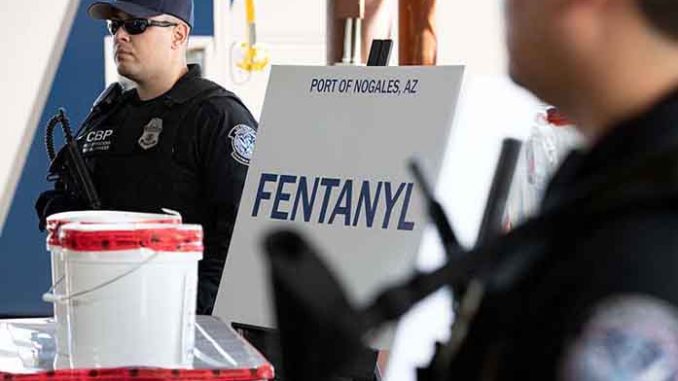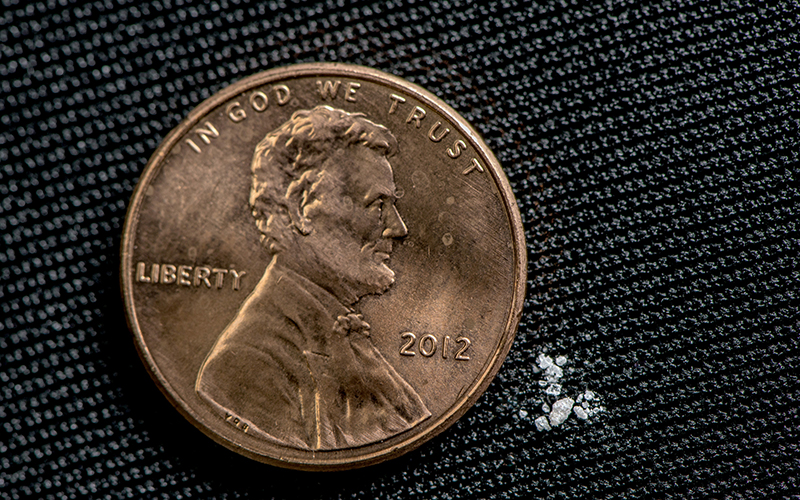
WASHINGTON – Compared to the tons of marijuana and the thousands of pounds of heroin that are confiscated at the border in a given year, the amount of fentanyl that was seized in Nogales recently may seem small.
But Erica Curry of the Drug Enforcement Administration’s Phoenix office says a small amount of fentanyl could have deadly effects that outweigh all the other drugs.
“In Arizona in 2018, DEA and our law enforcement partners have seized 445 pounds of fentanyl,” Curry said, “which is roughly enough to kill 75 million people.”
That’s because experts say that as little as 2 milligrams of fentanyl can be a fatal dose. With more than 450,000 milligrams in a pound, that could theoretically produce 225,000 fatal doses.
DEA spokesman Melvin Paterson puts it in perspective this way: If you put fentanyl in a salt shaker, there would be enough of the drug in one shake to kill.
“We know that 2 milligrams for the average person that’s not using any type of opioids, that would be a deadly or lethal dose,” said Patterson, of the DEA’s Washington office.
Customs and Border Protection officers in Nogales made the largest fentanyl seizure in the agency’s history in late January when they confiscated 254 pounds of the drug valued at $3.5 million. The fentanyl was hidden, along with methamphetamine, under the false bottom of a truck that was bringing a load of cucumbers across the border.

That single seizure was more than half the 445 pounds of fentanyl confiscated in Arizona for all of 2018, according to DEA statistics.
And fentanyl is showing up in a lot of different places. Officials say fentanyl is often found mixed with other opioiods or pressed into pills and passed off as legitimate prescription medication.
“It’s very uncommon for us in DEA to seize coke (cocaine) or methamphetamines or heroin and it not have some fentanyl in it,” Patterson said.
Morgan Clothier, a forensic chemist in the Washington, D.C., Department of Forensic Sciences, said they see it in her office, too.
“Fifty percent of the heroin cases that we handle in our lab contains fentanyl or another fentanyl analog,” she said.
Clothier said it is impossible to tell the difference between street and legal versions of a drug with the naked eye – the only way to find out if fentanyl is present is to test the drug. Even that requires special care because of the danger the drug presents. Clothier said fentanyl is “repacked in an additional external packaging so that way when it crosses hands … it is an extra layer of protection.”
Because it is a synthetic drug, fentanyl is relatively easy to produce and package as legitimate, experts say, but with none of the safeguards. Curry said “there’s really no way to know how much fentanyl is in whatever it is that you are taking.”
“The pills are manufactured to resemble legitimate pharmaceutical drugs like oxycodone and … Percocet, however, they are not,” she said. “These are pills that are counterfeit, are fake.
“There’s no quality control to the production of these pills whatsoever,” Curry said. “So a pill that you think is legitimate is actually very, very powerful. And just by taking one, one pill you can actually overdose and die from that.”
Fentanyl is not all bad. In prescription form, it is used to relieve severe, ongoing pain.
“Doctors use of fentanyl is meant to treat cancer patients, they use fentanyl as a pain medication,” Patterson said.
But even the legitimate version has risks – WebMD suggests that patients ask their doctors if they should also have naloxone available, the drug used to treat opiod overdoses.
Despite the dangers of fentanyl, Patterson says Americans have no one to blame for the growing problembut themselves and the demand they have created for the drug.
“We have some ownership and we have to start listening to our officials,” he said. “People with the FDA (Food and Drug Administration), HHS (Health and Human Services) that are saying these substances are very, very dangerous.”
-Cronkite News video by Luv Junious
